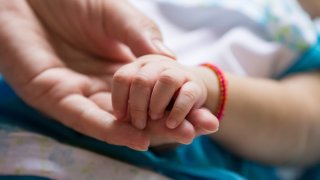

The following content is created in partnership with Stanford Children's Health. It does not reflect the work or opinions of the NBC Bay Area editorial staff. Click here to learn more about Stanford Children's Health.
It’s no secret that organ donations can be a controversial topic. Because of the various myths surrounding it, many people are reluctant to add that little heart to their driver’s license. However, organ donation is meant to be an amazing act that transforms grief into second chances, which is exactly what happened to Maya Hancock.
Maya's story
Get a weekly recap of the latest San Francisco Bay Area housing news. Sign up for NBC Bay Area’s Housing Deconstructed newsletter.
Everything was going smoothly for baby Maya Hancock until when on her 2-month checkup, her pediatrician noticed something was off. “We noticed Maya’s color was a little off at her 2-month well-child visit. Her doctor said, ‘It’s probably just breast milk jaundice, but let’s do a blood draw just in case,’” explained Lindsay Yuh, Maya’s mother.
She was then diagnosed with biliary atresia—a rare liver disease affecting the bile ducts. Though rare (it occurs in 1 out of 8,000 to 18,000 infants in the U.S. every year), biliary atresia is the main reason for liver transplants in infants, and Maya was no exception. Although she underwent surgery to remove the damaged ducts, her bilirubin levels were soon back to their starting point, resulting in getting added to the donor waitlist.
“We got a referral to Stanford Children’s Health, and we met with the liver transplant team virtually in early December 2020. Maya then underwent a complete evaluation by a multidisciplinary transplant team. A week later she was put on the donor waitlist,” said Yuh. The program, known nationwide for performing highly complex liver transplants with exceptional results, offers 10 outreach centers in 6 states, along with telehealth visits, so that it can provide lifelong care to transplant patients like Maya.
Fortunately, Maya’s family received two calls regarding potential donors—one living, one deceased—within a few weeks. Her transplant surgery was quick and successful, and the donated liver fit perfectly. According to her parents, both Maya’s mood and physical aspect took a wide turn once she had her new liver.
“Mason (Maya’s father) and I both remarked on how her appearance changed after surgery. Her skin looked good, and her eyes were clear for the first time, and she began to smile again. During recovery, she had a voracious appetite. All of a sudden, she was really interested in food! She was like a completely different child,” Yuh said.
Yuh and Hancock have endless words of thanks and tears of gratitude for the family that donated their child’s liver. Yuh chokes up when talking about the incredible gift they gave her family, and she marvels at how doctors can take a donated organ from a deceased person, put it into a living child and watch it come to life. “We talk to the donor family in our minds all of the time, and we consider how their grief became our life. We want them to know how amazing Maya is and to know that we could not have done it without them,“ Yuh concludes. “We are forever grateful to them, and to Stanford Children’s Health.”
But how exactly do organ donations work? The process takes healthy organs from one person (donor) and places them into another (recipient). The recipient needs the organ because theirs has either failed or been damaged. According to the Health Resources and Services Administration, 17 people die each day waiting for an organ transplant. Maya’s case was rare because she found two donors in such a short time span. Many people wait years and some even die before being matched with a donor.
A big reason behind this is the fact that many fall prey to common misconceptions regarding organ donations, some of which include:
Being too young or too old
As seen in Maya’s case, even newborn babies need organ donations from other infants around the same age. This means that there’s no minimum age requirement to donate—and receive—an organ. People of all ages need organ transplants and therefore, people of all ages can be donors. There’s no such thing as being “too young” or “too old.”
Organ donation goes against most religions
If you find yourself unsure of what your religion’s stance is, ask a member of your clergy. However, most religions approve of organ donations and in fact, consider it an act of kindness and generosity. When choosing to donate, you’re giving hope and a second chance to thousands of families like Maya’s.
Not being in optimal health may disqualify a person from donating their organs
When the time comes, the transplant staff will determine whether the organs can be donated or not. Don’t disqualify yourself ahead of time; you might be surprised by how different the criteria for different organs and hospitals can be.
If the individual decides to donate their organs, the hospital staff won't try as hard to save their life
Another common myth is that donors are always deceased. This is false, as we see in Maya’s first candidate who was a close family friend who would have needed to undergo a small surgery to remove a piece of their liver (which regenerates itself after a few weeks).
And while most organ donations come from deceased donors, this doesn’t mean that the hospital won’t try to save them when they’re fighting for their lives. If a registered donor’s life is in danger, their number one priority will always be to save that life. The medical staff is not directly related to the transplant staff—which is not called until death is declared.
The matching system is rigged and the wealthy or influential get priority treatment
Organ recipients are selected based on medical need, location, and compatibility. Maya, for instance, was a normal baby from a normal family in terms of influence or wealth. She was, however, placed high on the transplant waitlist due to her severe illness and urgent need for treatment.
Family being charged for the donation
Organ donation is free of charge, both on the donor side and for the patient who will receive the organ. If efforts are made to save the donor's life before the organ donation, those costs will be charged—not for the donation itself.
Becoming a donor
If you're wondering how to become an organ donor, you can do so in the following ways:
- Register with your state's donor registry.
- Add a heart to your driver's license.
- Let your family know about your wishes.
With over 100,000 people in the U.S. waiting for an organ transplant, signing up to be an organ donor can have a tremendous impact.
The myths regarding organ transplants don’t end there. Luckily, experts at Stanford Children's Health Pediatric Transplant Center are ready to answer any further questions you may have. Click here to learn more.

